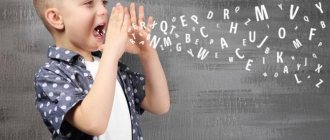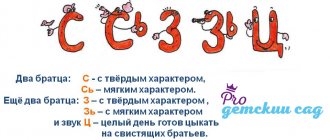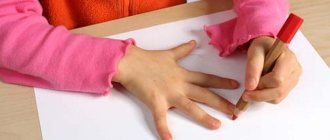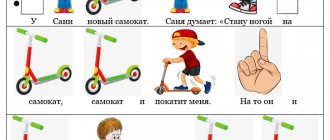Speech is the main means of communication among people. Therefore, it is so important that the child develops it correctly. One of the indicators is clear pronunciation of all sounds by the age of 5–6 years. And kids can’t do it without parental help. How to teach your child to say all the letters correctly? What should you do for this?
A bit of "general theory"
First of all, it is important to understand that a little person’s speech develops in stages. Experienced parents probably remember that in the first months of life their baby chanted vowel sounds, then began to hum, pronouncing syllables with simple consonants, then came the first onomatopoeia (“am-am”, “av-av”) and the first words.
- Closer to one year, the child can say “mom,” “dad,” “baba,” “uncle,” “give,” and perhaps several other words. He also uses the “wrong” words (“kup-kup”, “bye-bye”).
- From one to two years old, the baby learns to formulate the first simple sentences (“I’ll have soup”, “Dad, give me”). If the syntactic structure of a sentence (subject - predicate) can be traced, no attention is yet paid to the purity of sounds: the child’s articulatory apparatus is not yet sufficiently formed for this. But the so-called “passive” vocabulary, which began in the first months, is being replenished by leaps and bounds: the child learns to understand new words, remembers their pronunciation and meaning, although he does not yet know how to pronounce them. Later they will turn into his active speech. Now he no longer just pronounces the “vocabulary set”, but listens to how he says these words and the sounds in them, and is able to evaluate whether it is correct or not.
- Around 3 years old, a child learns to repeat short poems, as well as construct complex sentences with the words “because”, “which”, “so that”. Most often, it is at this age that whistling sounds (S, Z, C) “ripe.” But even if they are still being replaced (for example, by the sound T), but the child’s intelligence is developing normally (he understands speech addressed to him, knows the names of his relatives, or that animals also have mothers and fathers) - there is no reason to worry.
- By the age of 4, the child should know general words (what are dishes, transport, toys, clothes). The pronunciation may not yet be very clear (hissing and P are the ones that suffer most often).
- At the age of 5, a child must correctly pronounce all sounds, since by this time the parts of the brain responsible for the development of speech have been sufficiently formed, and the speech apparatus has reached the required “condition” (provided that the child has been constantly trained: speech itself is not will come “out of nowhere”).
Games and exercises for the development of phonemic hearing in children 3-4 years old
"Far and Near"
The essence of the game:
⠀
You say a word loudly and say that this word sounds loud because I am next to you. Then move away and say another word, only more quietly. Ask your child to repeat the word and tell him that it sounds quiet because you are standing far away.
⠀
Then you alternately name the words, either quietly or loudly, and the child must say which words sound “far” and which “close.”
⠀
This game teaches your child to recognize and remember sounds in words.
"Right wrong"
You will need picture cards. Suitable pictures for development 0+, where various objects, plants and animals are drawn.
⠀
The essence of the game:
⠀
Take a card with any picture and ask your child to clap if you incorrectly name the object in the picture. For example, let there be a card with an apple. You show it to the child and say: “MAP.” The child claps and you ask him to name the word correctly. You can also intentionally miss a sound in a word and the child must correct you.
⠀
Thanks to this exercise, the child remembers the correct sound of words, which will help him make fewer mistakes when learning to read.
"Extra syllable"
The essence of the game:
⠀
You monotonously repeat the same syllable to the child, and then add another syllable to this identical series. At this moment, the child should stop you with a clap and name the extra syllable. For example, you say: “GA-GA-GA-GA”, and then insert “YES” and continue to “gag” further. The child hears a different sound, claps his hands and names the extra syllable.
⠀
This game develops hearing well, trains attention and teaches you to distinguish sounds.
Speech development and parental involvement
So what is parental help? First of all, it is important for adults to understand that it is impossible to simply teach a child to say letters. This process is long, systematic and comprehensive. Children’s speech develops along with the improvement of other skills: both psychomotor and physical. If the baby is behind in development (he started holding his head up late, sitting up, he has problems with memory, attention) - speech will most likely also lag behind.
What needs to be done to ensure that everything happens on time? Firstly, monitor overall development - train muscles, dexterity, motor skills, memory, attention.
The following aspects are especially important for developing speech skills.
- From a very early age, parents should speak to the child clearly and correctly: without childish touching “lisping”, without adjusting words to the child’s age. Yes, a baby can speak incorrectly due to age-related imperfections of his speech apparatus. But he should hear only accurate speech around him: correct, clear, literate, without verbal garbage (“well this”, “damn”, “in short”, “what”), otherwise the incorrect pronunciation will become fixed in his speech and then these problems will arise adjust with specialists. And this is much more difficult.
- The process cannot be left to chance. With such a passive approach, the baby will certainly begin to lag behind. Teaching him the correct pronunciation is just as important as teaching him to hold a spoon or pull on tights.
- There should always be an active speech environment around the child. He must hear speech all the time. You need to comment on all actions, talk about everything that is happening, and name all the surrounding objects. Then the child from an early age will not only enrich his passive vocabulary, but also understand the importance of speech for communication.
Playing with fingers and shadow
Showing letters with your fingers is an entertaining game where both the child and the parent can be the leader. For example, a baby shows a letter with his fingers, and his mother tries to guess this letter. And vice versa. In addition, you can arrange a real shadow theater by guessing the letter from the shadow of folded fingers.
These methods and techniques can be used separately or together, successfully complementing each other. It is important for a parent not only to teach the child the alphabet, but also, most importantly, not to discourage the child’s desire to independently explore the world, to instill in him an interest in learning, reading and writing.
- share with your friends!
What exactly are we developing?
First of all, of course, a passive dictionary. But it is not only he who contributes to the development of pronunciation skills. Thus, it has long been proven that the brain centers responsible for the development of fine motor skills and speech are located nearby and influence each other. Therefore, in order to ensure that the baby does not have problems with speech, it is important to pay attention to the development of fine motor skills. These could be activities such as:
- finger exercises or finger massage (at a very early age);
- sorting through cereals, small buttons, nuts;
- lacing, fastening zippers, buttons;
- screwing caps on bottles;
- finger painting on sand, semolina, flour;
- painting, modeling;
- stringing large beads on a string.
And in order for the speech apparatus to be in good shape, it needs to be constantly trained. For this purpose, special articulation gymnastics complexes have been developed. They help the child’s lips, tongue, jaws, and cheeks acquire the necessary strength, tone, mobility and controllability, learn the correct force and direction of air supply when speaking, and make speech rhythmic and beautiful. Only the correct functioning of these organs will help the baby master the necessary pronunciation. We talked about articulatory gymnastics in detail in this article.
When starting any classes with a preschooler, remember that they should last no more than 15 minutes. Pay attention to the baby's mood and willingness to accept the game. If he doesn’t want to, don’t insist, don’t force (especially don’t promise “heavenly punishment”!). Otherwise, having once felt such an attitude, the child may lose interest in any learning for the rest of his life or even begin to hate it.
Cubes
If you don’t have time to make cards yourself, then bright cubes with pictures for each letter will come to the rescue. This is a quick and familiar way to teach a child to memorize the letters of the alphabet. Nowadays you can find a wide variety of cubes: colorful, funny, soft, wooden or plastic.
With cubes, you can also come up with a variety of games for memorizing letters at home, which will help awaken an interest in learning the alphabet and reading in a three- to four-year-old child.
Preparing to produce sounds
There is no need to wait until 5–6 years to see that the child cannot pronounce some letters. Very often the problem can be prevented (and it is much easier than fixing it later). To teach a child to speak a sound, you just need to systematically perform a set of exercises, which, together with articulatory gymnastics, will help the baby’s organs “understand” how to behave when pronouncing certain sounds. Or letters - many call it that (although the sound is more correct: a letter is a graphic outline of a sound).
So, speech therapy exercises that will help the child pronounce sounds can be like this.
- We strengthen the muscles of the tongue so that it can remain at the top behind the upper teeth in a raised state for a long time. This is the defining moment for pronouncing the sounds [h], [sch], [sh], [zh], [l] and [r] - problematic for many children. Speech games are suitable for this (it is better to carry them out in poetic form, with some theatricalization of the process), in which the baby will have to repeat many times: “you-dy” (“tyn-dyn”), “so-so”, “dy-dy” ", "Yes Yes". These are the syllables in which you have to raise and hold the tongue at the top. Here it is important to vary the strength of the voice, intonation, speed of pronunciation, and also to ensure that the tip of the child’s tongue during exercises does not fall towards the lower teeth, but remains behind the upper teeth all the time.
- We strengthen the root of the tongue so that it can rise to the palate. This is necessary to pronounce the sounds [g], [k], [x]. Let the child imagine that he is a marksman, in front of whom there is a shooting range with targets. His task is to “hit” all the “targets” with a gun (the shot is “cough-cough”). You can “shoot” until the child gets tired. You can make the shooting range a reality by hanging targets and giving your child a water pistol. He must shoot with the same sound: [kh].
- We teach the baby to close his lips. Adenoids, malocclusion, or other features may cause a child to be unable to close their lips tightly. In this case, the pronunciation of the sounds [p], [b], [m] (these are just “labial” sounds) suffers greatly. To teach your child to pronounce them, you can play drummers or rain with thunder - the main thing is that during such a game he pronounces the characteristic syllables: “bom-bom”, “boom-boom”, “boom-boom”, etc. It is necessary to ensure that the baby’s lips close very tightly when performing such exercises, even slightly “overplayed.” This will strengthen the muscles around the mouth faster, and the child will be able to close his lips. Accordingly, he will be ready to pronounce labial sounds that are still difficult for him.
- We develop the cheeks. With the help of the “hamster” game, the baby will learn to use his cheeks - after all, they are also involved in pronunciation. We invite him to puff out his cheeks, as if his mouth is full of food, and begin to “chew” with concentration (cheeks puffed out, lips closed). At the same time, the jaws and almost all facial muscles also work.
Learning letters with a child in the first years of life
If parents (most often mother, but there are options in the form of father or grandmother) want to teach their child letters as early as possible, then they should be guided by the motto “it’s never too early to start.”
For a toddler of the first year of life, you can print or draw letters on an A4 sheet (one letter per sheet) and hang them around the room, but not all at once (3-4 letters at a time are enough). While awake, the baby can be brought to these pictures from time to time and called out the letters depicted. The exposure should be changed from time to time, that is, instead of some letters, others should be hung.
When the child grows up a little, it makes sense to purchase a magnetic alphabet (you just need to make sure that the magnets do not fall out of the letters). Another interesting option could be a puzzle floor mat with letters.
Just don’t immediately dump numerous literacy aids on your child, let everything go gradually. They put several letters on a magnetic board or refrigerator, sang funny songs, played a little on the rug, simultaneously pulling out this or that letter from it and naming it, and again got down to important little things. Training should not be academic in nature; ideally, it flows so smoothly into the little one’s play that he simply does not notice that they want to teach him something.
Parents can make educational material themselves .
These are various cards with letters, large letters made of cardboard that you can hide (and then have fun looking for), give to each other, and even walk and jump on them! The main thing is to make sure that the child enjoys playing with these strange icons, so that he himself asks to continue the exciting game! In addition, today there are many methods and aids that help teach a child letters and sounds. Various primers, books with stickers, coloring books, lotto, dominoes, special children's presentations, children's computers and computer games for learning letters and sounds - parents only need to choose what is right for their child, taking into account his age, temperament, perseverance, interest in the process of learning and health (for example, it is very undesirable for children with weak eyes to spend time looking at the monitor screen).
You can start introducing alphabet books and alphabet books with bright and clear pictures to your little one from the age of one and a half to two years old; you can try to play board and computer games when you are closer to three years of age. Of course, it is necessary to choose books and games that are designed specifically for the “diaper” audience, so that the child finds it interesting and not boring to study.
An interesting method of teaching a child letters is to “hide” them in familiar objects (for example, make a house from the letter “D”, and make a beetle from “F”). A similar technique was used by some compilers of alphabet books and primers; you can also read about it in Cecile Lupan’s book “Believe in Your Child,” which provides recommendations for teaching the alphabet with the help of funny pictures. To make it more interesting for the little one, you can draw letters with eyes, noses, mouths and arms and legs.
Games for children 4–5 years old
"Sound Lost"
The essence of the game:
⠀
Make a sound with your child that he will look for in words. Let him choose which one he likes best. Let's say "M". Then start saying different words with and without this sound. The child should stamp his foot or clap when he hears a word with the sound “M”: DRUM, FLOWER, APPLE TREE, BANANA, STORE, OWL, MOTOR.
⠀
This exercise also trains attention, hearing and correct perception of sounds.
"Lost Word"
The essence of the game:
⠀
This game is similar to the previous one. Only here you need to look not for a sound, but for a word that is lost among words that sound similar. Make a word with your child, for example “POT”. Then say consonant words: DAUGHTER, CAR, LOBE, HUMM, KIDNEY, POINT, BARREL. When a child hears a lost word, they should respond by clapping or jumping.
"You are my echo"
⠀
The essence of the game:
⠀
Invite your child to play echo. Say: “You will be my echo. I will speak, and you repeat after me.” Then go to another room and start the game. Choose words and sounds that your child pronounces with errors or difficulty. By repeating after you several times, your child will hone the correct pronunciation.
Games for children 5–6 years old
"Singing Lotto"
This game must have a leader and at least two participants. It is designed for children who already fully or partially know the alphabet.
The essence of the game:
⠀
Take picture cards and blank cards. Give the children 5-7 cards with pictures and the same number of blank ones. Then sing any sound and ask who has pictures of an object containing that sound. Children find a suitable card, say the word and cover the image with a blank card. The winner is the one who closes all the pictures the fastest.
⠀
For example, you start: “Uuuuuuuu” and ask who has an image with that sound. The child raises his hand and says: “Uuuuu-tka” and covers the picture with a blank card.
⠀
This exercise helps children quickly master reading syllables.
“Complete the missing syllable or word”
Simple sentences from your child’s favorite fairy tales are suitable for this exercise.
⠀
The essence of the game:
⠀
You read the sentence to your child, but do not say the last syllable or word. The child must complete the word and speak the entire sentence.
⠀











